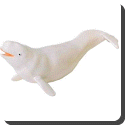 Beluga — His small whale can be up to 5 metres (16 ft) long, larger than all but the largest dolphins but smaller than most other toothed whales. Males are generally larger than the female – males can weigh 1,360 kg (3,000 [Pound (unit of weight)|lb]) and females about 900 kg (one short ton).
Beluga — His small whale can be up to 5 metres (16 ft) long, larger than all but the largest dolphins but smaller than most other toothed whales. Males are generally larger than the female – males can weigh 1,360 kg (3,000 [Pound (unit of weight)|lb]) and females about 900 kg (one short ton).
Newly-born belugas are about 1.5 m (5 ft) long and weigh 80 kilograms (176 lb).The baby beluga is usually born grey but not always. This whale is unmistakable when adult: it is all white and has a dorsal ridge rather than a fin. The head is also unlike that of any other cetacean – its melon is extremely bulbous and even malleable. The beluga is able to change the shape of its head by blowing air around its sinuses. Again unlike many dolphins and whales, the vertebrae in the neck are not fused together, allowing the animal flexibility to turn its head laterally. The belugas mouth is called the rostrum. The rostrum has about 8 to 10 teeth on each side of the jaw.
The absence of the dorsal fin is reflected in the genus name of the species – apterus is the Greek word for “wingless”. The evolutionary preference for a dorsal ridge in favour of a fin is believed by scientists to be adaptation to under-ice conditions, or possibly as a way of preserving heat. Like in other cetaceans the thyroid gland is relatively large compared to terrestrial mammals (three times per weight as a horse) and may help to sustain higher metabolism during the summer estuarine occupations.
The body of the Beluga is rotund, particularly when well-fed, and tapers smoothly to both the head and tail. The tail fin grows and becomes increasingly ornately curved as the animal ages. The flippers are broad and short – making them almost square-shaped.
Males become sexually mature at eight years, females at five. Seasonally polyestrus females give birth to a single calf in the spring after a gestation period of fifteen months with ranges found from 14.5 in the wild to 15-17 months in captivity. Young Belugas are uniformly dark grey in colour. The grey steadily lightens as they grow up – reaching their distinctive pure white colour by the age of seven in females and nine in males. The nursing period is about two years in length. The mating process is not properly understood. Testosterone levels in males have been found to be lowest in September and then rose to be highest in march with peak sperm production thought to occur perhaps in May or June if their physiology mimics other mammals. Mating certainly does occur during the winter or early spring, when the animals are still in their winter grounds or have begun their migration. However, mating occurs at other times, leaving open the possibility of delayed implantation. Belugas can live for up to fifty years. Females in captivity have been found to conceive as old as 20 years.
Beluga whales have a life expectancy of 25-30 years.
Beluga whales are highly sociable creatures. Groups of males may number in the hundreds, but mothers with calves generally mix in slightly smaller groups. When pods do aggregate in estuaries, they may number in the thousands. This can represent a significant proportion of the entire Beluga population and is the time when they are most vulnerable to hunting.
Beluga pods tend to be unstable, meaning that belugas tend to move from pod to pod. Pod membership is rarely permanent. Radio-tracking has shown belugas can start out in a pod and within a few days be hundreds of miles away from that pod. The closest social relationship between belugas is the mother-calf relationship. Nursing times of 2 years have been observed and lactational anestrus may not occur. Calves often return to the same estuary as their mother in the summer, meeting with their mother sometimes even after becoming fully mature.
Beluga are also known for being rather playful, as well as spitting at humans or other whales. It is not unusual for an aquarium handler to be sprayed down by one of his charges whilst tending a beluga tank. Some researchers believe that this skill may be utilized to blow away sand from crustaceans at the sea bottom.
 Kids Portal For Parents India Kids Network
Kids Portal For Parents India Kids Network






